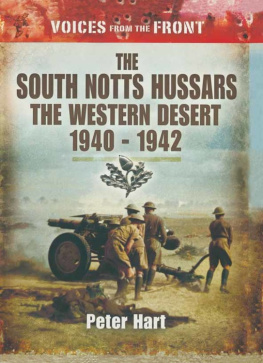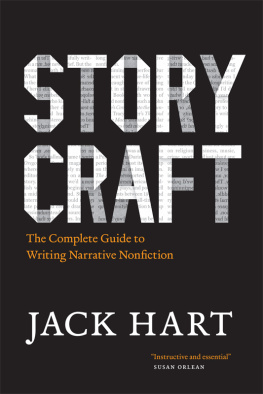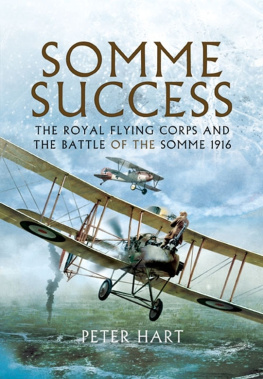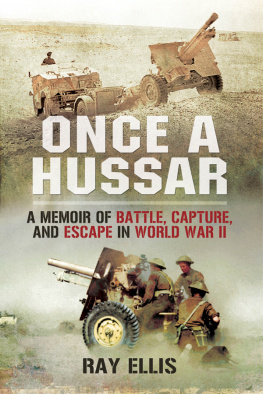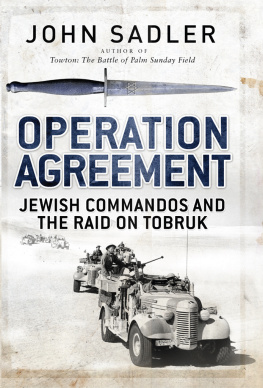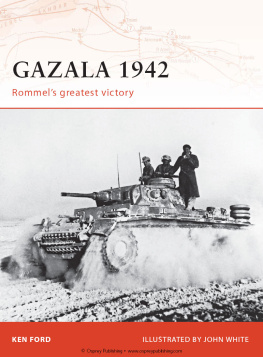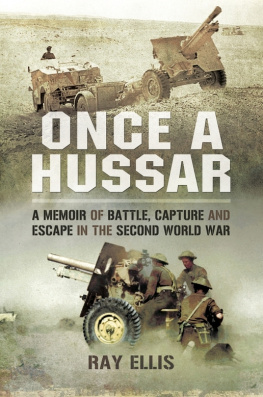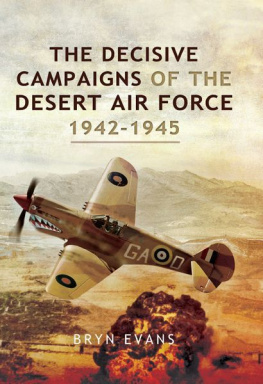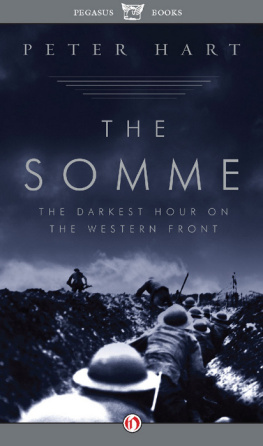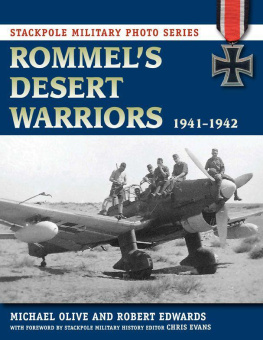VOICES
from
THE FRONT
VOICES
from
THE FRONT
The South Notts Hussars:
The Western Desert
19401942
Peter Hart
First published in Great Britain in 1996 by
LEO COOPER
Reprinted in this format in 2010 by
Pen & Sword Military
an imprint of
Pen & Sword Books Ltd
47 Church Street
Barnsley
South Yorkshire
S70 2AS
Copyright Peter Hart, 1996, 2010
ISBN 978 1 84884 403 2
The right of Peter Hart to be identified as
author of this work has been asserted by him in accordance
with the Copyright, Designs and Patents Act 1988
A CIP catalogue record for this book is
available from the British Library
All rights reserved. No part of this book may be reproduced or
transmitted in any form or by any means, electronic or mechanical
including photocopying, recording or by any information storage and
retrieval system, without permission from the Publisher in writing.
Printed and bound in England by
CPI Antony Rowe, Chippenham, Wiltshire
Pen & Sword Books Ltd incorporates the imprints of
Pen & Sword Aviation, Pen & Sword Maritime, Pen & Sword Military,
Wharncliffe Local History, Pen & Sword Select,
Pen & Sword Military Classics and Leo Cooper,
Remember When, Seaforth Publishing and Frontline Publishing
For a complete list of Pen & Sword titles please contact
PEN & SWORD BOOKS LIMITED
47 Church Street, Barnsley, South Yorkshire, S70 2AS, England
E-mail: enquiries@pen-and-sword.co.uk
Website: www.pen-and-sword.co.uk
Contents

I am greatly indebted to the old comrades of the South Notts Hussars without whom this book would not exist. My own role has been merely to select and link together within a historical context the various extracts from the remarkable recordings they have made for the Imperial War Museum. I must particularly thank in alphabetical order Ray Ellis, Bob Foulds, Harold Harper, Frank Knowles and John Walker to whom I have frequently turned for help over the last five years and have never been disappointed. I would also like to thank my tireless colleagues in the Sound Archive at the Imperial War Museum: Margaret Brooks, Kate Johnson, Laura Kamel, Rosemary Tudge and Conrad Wood. Together they have amassed an archive which is a fantastic treasury of human experience and knowledge for those willing to use it. I am grateful to my friend and colleague Nigel Steel from the Department of Documents who has brought his finely honed mind to bear on the many grammatical errors which littered this text. Of course my own natural stubbornness is responsible for any slips that remain! Paul Kemp and Dave Parry of the IWM Photographic Archive were extremely helpful in selecting many of the photographs in the text. Many thanks to Ted Whittaker for the use of his cartoons. Ragnar Coop assisted by reading a preliminary draft and his comments were as pithy as ever. Suzanne Bardgett was a great help in preparing an early version of the Knightsbridge chapter which appeared as an article in the Imperial War Museum Review of which she was the esteemed editor. Roni Wilkinson of Wharncliffe Books was responsible for almost everything else and is a pleasure to work with.

A regiment is a strange organisation. It has a life separate from the experience of its serving members which reaches back in time and forward into the future. Although the men of the South Notts Hussars (SNH) who fought in the Second World War were not often aware of it, they were the direct descendants of the gentlemen yeomanry who had initially formed the regiment in response to Prime Minister William Pitts speech in Parliament on 5 March 1794. As an augmentation of the cavalry for internal defence was a very natural object, they might, under certain circumstances, have a species of cavalry consisting of Gentlemen and Yeomanry, who would not be called upon to act outside of their respective counties except on the pressure of emergency, or in cases of urgent necessity. The emergency that concerned him was the successes of the Armies of Revolutionary France and the rise of Napoleon Bonaparte. The men of Nottinghamshire responded and the nucleus of the regiment was formed at a meeting on 10 June 1794. Their first active service was not in fact against the French but in dispersing the local men engaged in the Luddite riots of 18111812. This was not as distasteful a duty as it might seem to men who were defending the perceived interests of their own class.
A Yeomanry regiment may be said to be an expression of the best of the county on horseback, and, like other Territorial units, partakes of that particular individuality that marks so distinctly every English shire, though it is hard enough to say sometimes where a county begins or ends. Nowhere, however, is this personal and intimate touch with its county more marked than in a Yeomanry regiment, with its ranks manned from the homesteads and farms whose tenure has often been held for several generations, and officered, as such regiments are, from the great houses.
Benson Freeman, SNH Historian
Under these circumstances it is not unnatural that they were enthusiastic in defending their privileged position within society and internal security was to be the main function of the unit during the turbulent early Nineteenth Century: the Brandreth riots of 1817; political unrest in 1819; the Reform Bill riots of 1831; the Chartist Riots and Demonstrations of 1839 and 1848 at all these the SNH defended the status quo with vigour. The introduction of an effective police service by the 1850s meant that in subsequent periods of popular unrest they were merely brought to readiness in case of a complete breakdown in law and order. The regiment remained a viable unit enduring the multitudinous problems caused by government military reforms and associated cutbacks but slowly the demographical factors generated by the industrial revolution and agricultural depression began to change the composition of the force commanded by the officers. As the true country yeoman ceased to exist recruits began to come in increasing numbers from Nottingham and its suburbs as the Twentieth Century loomed.
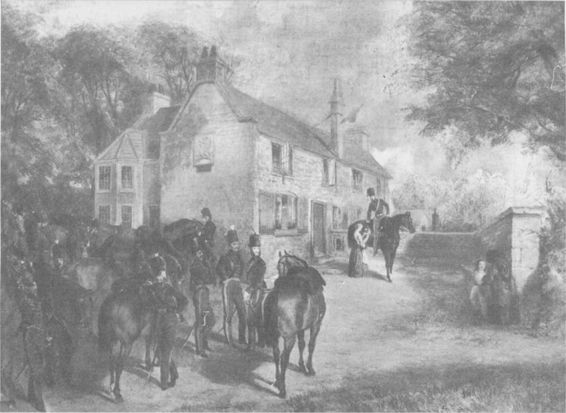
Yeoman taking their refreshment at a local hostelry.
The early disasters of the Boer War which began on 11 October 1899, brought the first opportunity for real active service. On 24 December 1899 an appeal was issued to form a SNH contingent within the 3rd Imperial Yeomanry Regiment and such was the response that a whole squadron was recruited under the leadership of Colonel Lancelot Rolleston. They embarked for South Africa in January 1900 and during the next two years took a considerable part in a series of actions with the Boers across the veldt; until finally the last contingent returned home following the declaration of peace in June 1902.
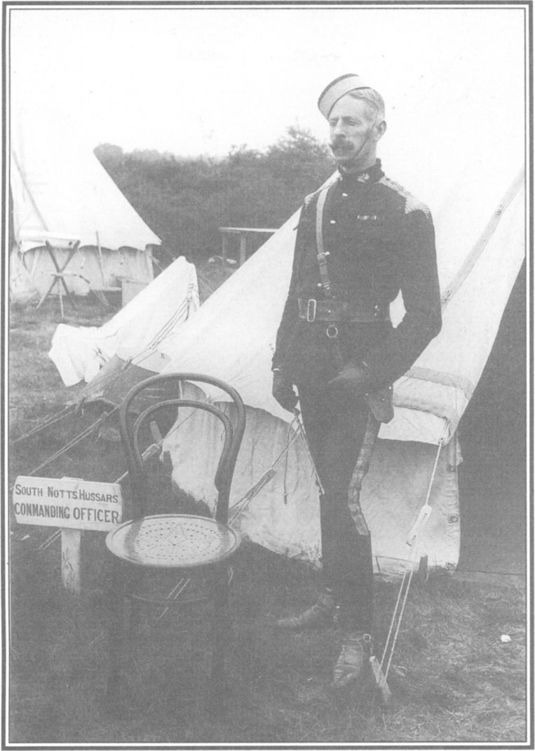
Colonel Lancelot Rolleston, a man with his own caption, at Summer camp, Aldershot, 1903.

